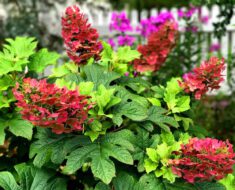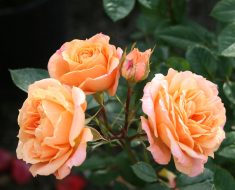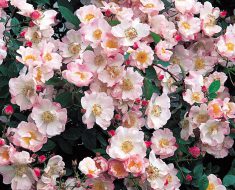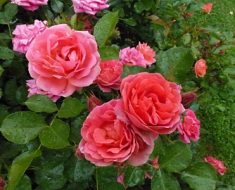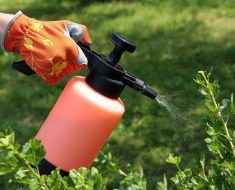Caring for roses is simple and many of the myths associated with it are just myths. The beginner beginner will cope with them. They should be planted in a sunny place with well-arranged drainage, properly watered, fed, trimmed and monitored for the appearance of diseases and pests.
It is easier to care for roses than for some other flowering shrubs, flowers or vegetables. For example, rhododendrons, azaleas, clematis or tomatoes. Modern roses – beautiful plants with high technical and biological characteristics. They can grow roses almost everywhere.
10 basic rules for growing beautiful roses
- Roots. For a beginner, it is better to buy roses in containers, so as not to cut off the excess or something that is sick, to miss badly damaged ones. After purchase, pour a good rose in a selling pot. Plant a flower in the evening. Dig a planting hole to the size of the pot. Carefully remove the earthen ball with its roots and place it on the bottom of the pit. Pour the void earth, gently rammed and pour. If you decide to buy a rose with open roots, then the roots should be a lot. At the aboveground part 3-5 shoots were formed. The optimum age of a sapling is 2-3 years. Before planting, the plant should be left in the water overnight. In the landing pit pour a hill of a mixture of earth, fertilizer, compost and sand. Spread out the roots on it and fall asleep in layers, watering each layer. Why soak overnight and water each layer when planting? In the first 2-3 months, the roots must be firmly rooted and put on new roots, and for this it needs a lot of moisture, which the upper irrigation cannot provide.
- Do not be zealous. Several well-chosen varieties will bring you more pleasure than a wide range, which you will not have time to manage. When you learn to care for roses once or twice, then expand the collection of ladies’ flower.
- The optimal place for landing. Walk around your site, watch the movement of the sun. Roses need 6-8 hour sunbathing. In cold regions, planting roses against a wall or fence on the south and west sides minimizes the effect of winter on flowers. The soil – fertile, rich in minerals and organic matter, with good drainage – is ideal. Usually, this is not the case everywhere. Determine the composition of the soil and try to bring it closer to the standard.
- The right time. It is better to plant roses in the spring, after the last frost. You can do this in the fall at least six weeks before the first frost in your area. This gives the roots enough time to root. Do not pull with landing: bought and immediately plant. The most it when day will be gloomy.
- Drainage and landing pit. Even for planting container roses, they dig a hole in such a way that an earthen ball goes in freely. Before installing the roses make a drainage. Roses do not like when their roots are in overmoistening. If you plant several bushes in one place, then leave them a space in 90 cm of one bush from another. This allows the rose to grow freely, and you can comfortably take care of it: water, cut, weed, inspect.
- Feeding. For a rich and beautiful flowering, rose bushes must be regularly fertilized. Organic is applied every month. It works well and stimulates beneficial microorganisms and maintains a pH balance. Granular mineral fertilizers provide the right balance of nitrogen, phosphorus, potassium and other minor nutrients. The content of nutrients in synthetic fertilizers is higher than organic. They are made at least once in the spring and once in the fall. Just planted a rose with a bare root system is fed only organic matter, so as not to harm the new roots. Chemistry is given when it blooms. Follow the instructions for use posted by the manufacturer.
- Life-giving moisture. Roses love when the soil is constantly in a moist state. The number and frequency of irrigation will depend on the type of soil and climate. Roses growing in sandy soils need frequent irrigation than heavier clayey lands. Hot and dry conditions also contribute to frequent irrigation. Do not water the roses over the leaves! They need the equivalent of 2.5 cm of rain per week (25 liters of water per 1 m²).
- Crop. Modern roses do not require heavy pruning. It is best to carry out the main pruning in early spring. First, remove all dead and damaged branches, and then cut last year’s healthy parts by from a third to half the height. In the summer, cut off flowers and brushes to stimulate the appearance of new ones. In grafted roses, wild shoots can sometimes appear, which must be cut as close to the base as possible. Such willows can kill a cultivated variety.
- Healthy roses. The best way to prevent diseases from occurring is to choose disease resistant varieties. These plants are selected and propagated to withstand the most fatal diseases, including powdery mildew and black spot. MR usually appears in the summer when the days are hot and dry, and the nights are cold and wet. Control signs are twisted leaves and powdered plaque. Pruning a rose bush provides air circulation and helps prevent MP powdery deposits. Black spot – a fungal disease that rises from the base of the plant to the top, causing the leaves to fall off. On their face black or brown circular spots appear. The emergency pruning and watering of a plant only by the area of the root system will help with the emergency. Roses feed harmful insects: aphid, spider mites, sawflies and others. Most pests are destroyed by insecticides. Aphids can be fought early in the morning with a strong jet of a hose that will flush it.
- Demonstration. Without admiring, there will be no enjoyment. This is also a kind of ritual part for the care of roses. We appreciate their fragrance, resistance and flowers. The most beautiful roses in the world are those grown with their own hands.
A few tips for flowers to stand longer in a vase.
- Roses stand longer if cut as soon as the bud begins to open.
- The tool must be sharp-sharp so as not to damage the canals of the plant that absorb water.
- Cut the roses early in the morning when they have dew on them and they are full of juice or late in the evening so that the plant is not subjected to the stress of hot weather and the sun.
- Cut off the stems at an angle of 45⁰ so that they do not abut the entire area of the cut in the bottom. Every 2-3 days, update the slice.
- Remove all the leaves below the water line so that bacteria do not grow and rot does not appear.
- Change the water often – every day.
Enjoy your growing!
